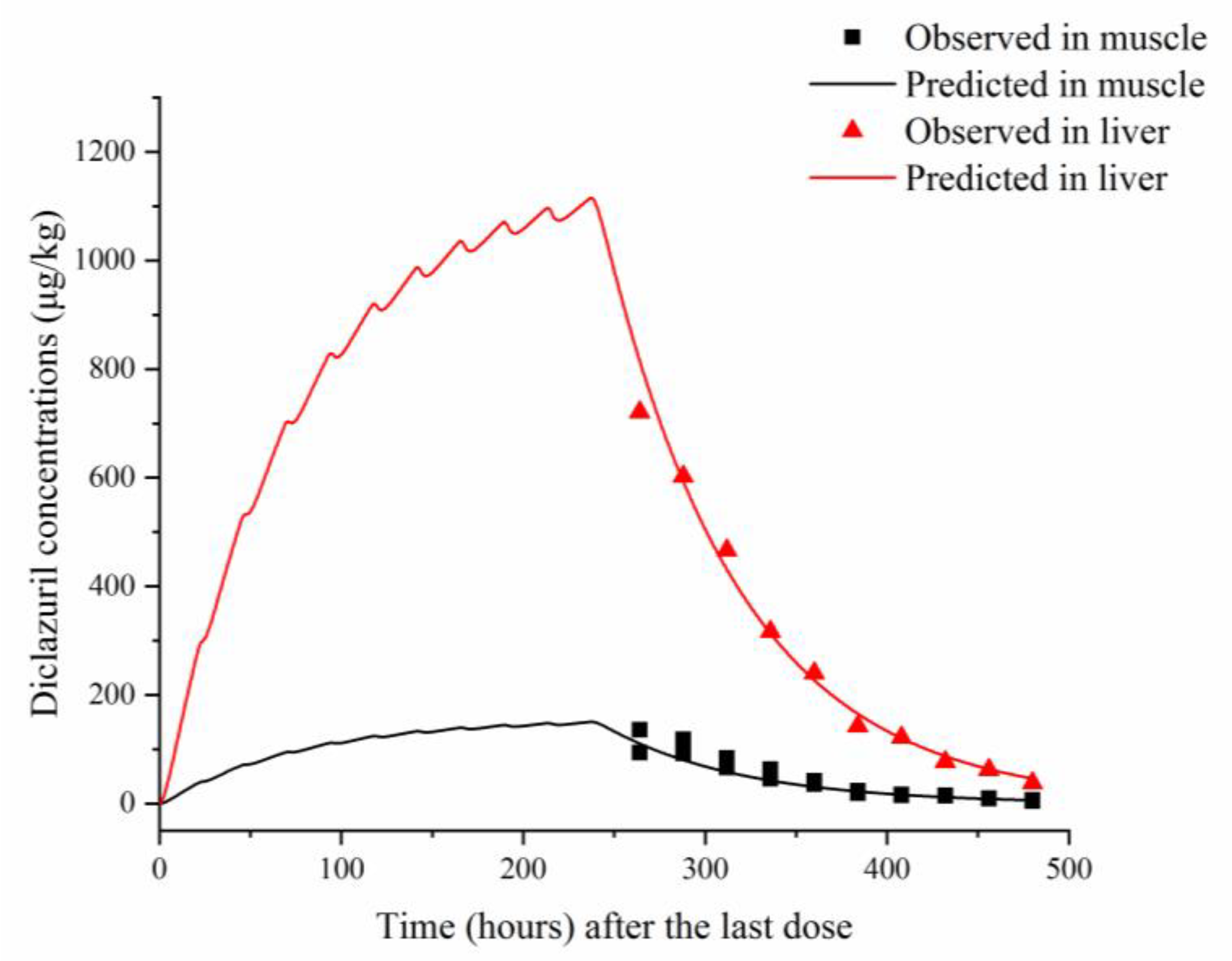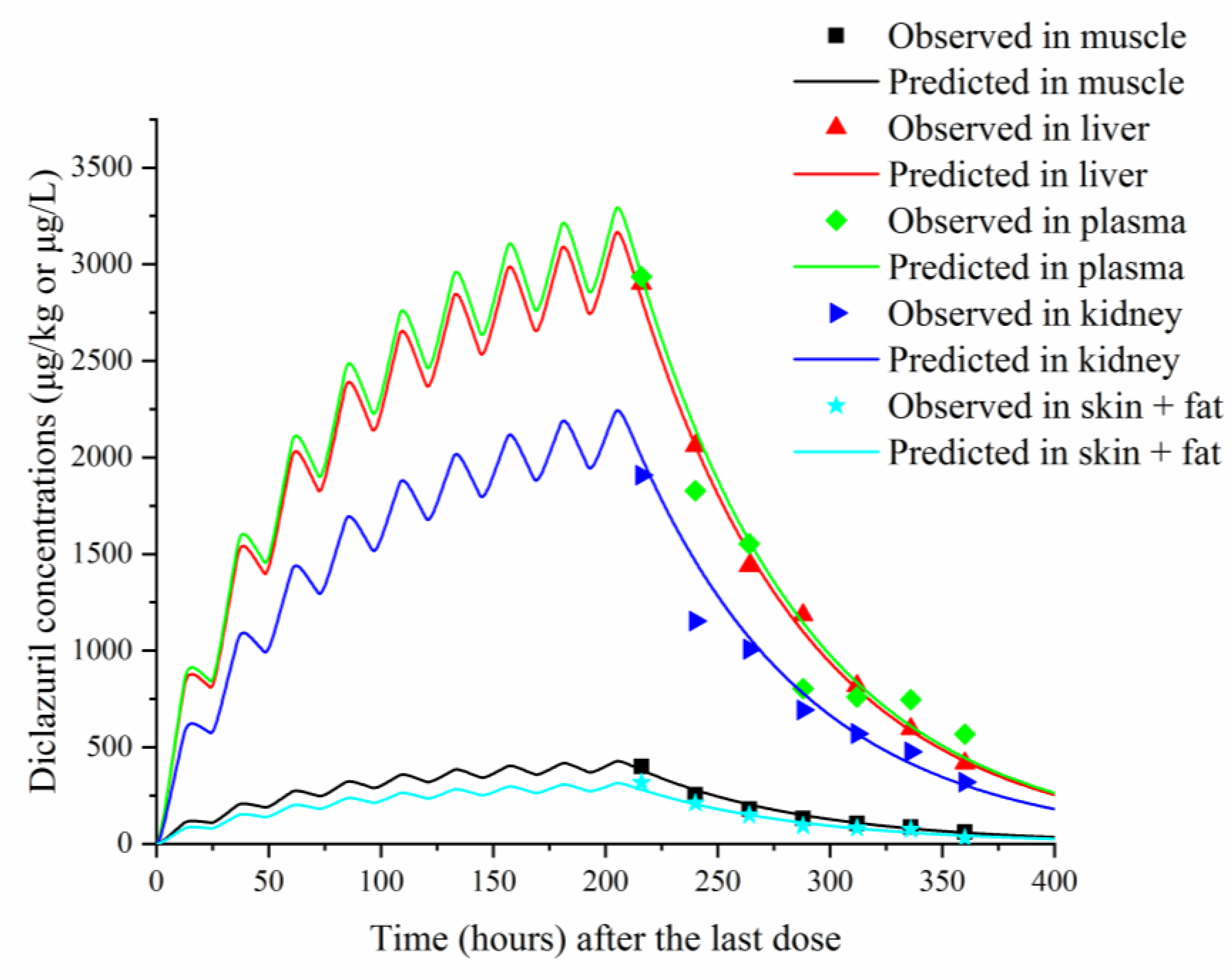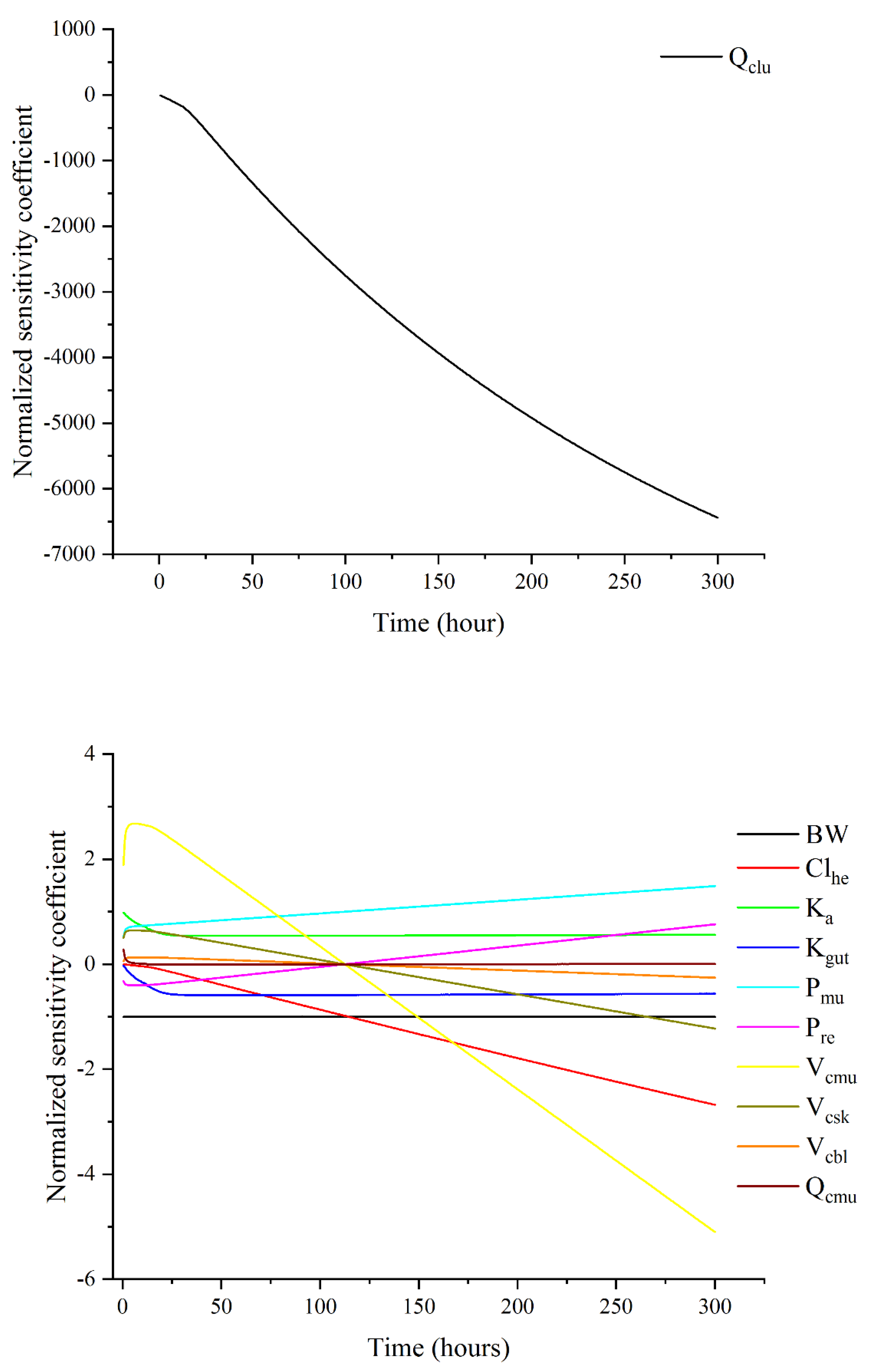Development and Application of a Physiologically Based Pharmacokinetic Model for Diclazuril in Broiler Chickens
Abstract
:Simple Summary
Abstract
1. Introduction
2. Materials and Methods
2.1. Concentrations versus Time Data
2.2. Model Structure
2.3. Model Parameterization
2.4. Model Validation
2.5. Sensitivity Analysis
2.6. Monte Carlo analysis and Withdrawal Interval Estimation
3. Results
3.1. Model Parameters
3.2. Model Validation
3.3. Sensitivity Analysis
3.4. Monte Carlo Analysis and Withdrawal Interval Estimation
4. Discussion
5. Conclusions
Supplementary Materials
Author Contributions
Funding
Institutional Review Board Statement
Informed Consent Statement
Data Availability Statement
Acknowledgments
Conflicts of Interest
References
- Zhang, M.; Qiu, J.; Shu, X.; Tang, X.; Sha, X.; Wu, L.; Fan, J.; Zeng, D.; He, R.; Zhang, W.; et al. Pharmacokinetics, activity, and residue elimination of R- and S-diclazuril in broiler chickens. J. Agric. Food Chem. 2020, 68, 8987–8995. [Google Scholar] [CrossRef] [PubMed]
- Del Cacho, E.; Gallego, M.; Lillehoj, H.S.; Quilez, J.; Lillehoj, E.P.; Sanchez-Acedo, C. Induction of protective immunity against experimental Eimeria tenella infection using serum exosomes. Vet. Parasitol. 2016, 224, 1–6. [Google Scholar] [CrossRef] [PubMed]
- Elokil, A.A.; Abouelezz, K.F.M.; Ahmad, H.I.; Pan, Y.; Li, S. Investigation of the impacts of antibiotic exposure on the diversity of the gut microbiota in chicks. Animals 2020, 10, 896. [Google Scholar] [CrossRef]
- CCVP (Commission of Chinese Veterinary Pharmacopoeia). The People’s Republic of China Veterinary Pharmacopoeia, 2020th ed.; China Agriculture Press: Beijing, China, 2021; Volume 1, pp. 94–96. [Google Scholar]
- WHO (World Health Organization). Toxicological Evaluation of Certain Veterinary Drug Residues in Food: Diclazuril (WHO Food Additives Series 41). Available online: https://inchem.org/documents/jecfa/jecmono/v041je08.htm (accessed on 20 March 2023).
- MARA (Ministry of Agriculture and Rural Affairs of the People’s Republic of China). National Food Safety Standard-Maximum Residue Limits for Veterinary Drugs in Animal-Derived Food. Available online: http://www.cfda.com.cn/newsdetail.aspx?id=107566 (accessed on 20 March 2023).
- EMA (European Medicines Agency). European Public MRL Assessment Report (EPMAR) Diclazuril (Extension to Poultry). Available online: https://www.ema.europa.eu/en/documents/mrl-report/diclazuril-extension-poultry-european-public-maximum-residue-limit-assessment-report-epmar-cvmp_en.pdf (accessed on 20 March 2023).
- Yang, F.; Liu, D.; Yang, C.; Song, Z.W.; Shao, H.T.; Zhang, M.; Zhang, C.S.; Zhang, Z.D.; Yang, F. Development and application of a physiologically based pharmacokinetic model for orbifloxacin in crucian carp (Carassius auratus). J. Vet. Pharmacol. Ther. 2022, 45, 311–319. [Google Scholar] [CrossRef]
- Yang, F.; Yang, F.; Wang, D.; Zhang, C.S.; Wang, H.; Song, Z.W.; Shao, H.T.; Zhang, M.; Yu, M.L.; Zheng, Y. Development and application of a water temperature related physiologically based pharmacokinetic model for enrofloxacin and its metabolite ciprofloxacin in rainbow trout. Front. Vet. Sci. 2020, 7, 608348. [Google Scholar] [CrossRef]
- Yang, F.; Yang, Y.R.; Wang, L.; Huang, X.H.; Qiao, G.; Zeng, Z.L. Estimating marbofloxacin withdrawal time in broiler chickens using a population physiologically based pharmacokinetics model. J. Vet. Pharmacol. Ther. 2014, 37, 579–588. [Google Scholar] [CrossRef]
- Tardiveau, J.; LeRoux-Pullen, L.; Gehring, R.; Touchais, G.; Chotard-Soutif, M.P.; Mirfendereski, H.; Paraud, C.; Jacobs, M.; Magnier, R.; Laurentie, M.; et al. A physiologically based pharmacokinetic (PBPK) model exploring the blood-milk barrier in lactating species—A case study with oxytetracycline administered to dairy cows and goats. Food Chem. Toxicol. 2022, 161, 112848. [Google Scholar] [CrossRef]
- Woodward, A.P.; Morin, D.; Whittem, T. Population physiologically based modeling of pirlimycin milk concentrations in dairy cows. J. Dairy Sci. 2020, 103, 10639–10650. [Google Scholar] [CrossRef]
- Li, M.; Gehring, R.; Riviere, J.E.; Lin, Z. Probabilistic physiologically based pharmacokinetic model for penicillin G in milk from dairy cows following intramammary or intramuscular administrations. Toxicol. Sci. 2018, 164, 85–100. [Google Scholar] [CrossRef]
- Baier, V.; Paini, A.; Schaller, S.; Scanes, C.G.; Bone, A.J.; Ebeling, M.; Preuss, T.G.; Witt, J.; Heckmann, D. A generic avian physiologically-based kinetic (PBK) model and its application in three bird species. Environ. Int. 2022, 169, 107547. [Google Scholar] [CrossRef]
- MacLachlan, D.J. Physiologically based pharmacokinetic (PBPK) model for residues of lipophilic pesticides in poultry. Food Addit. Contam. Part A 2010, 27, 302–314. [Google Scholar] [CrossRef] [PubMed]
- Van Eijkeren, J.C.; Zeilmaker, M.J.; Kan, C.A.; Traag, W.A.; Hoogenboom, L.A. A toxicokinetic model for the carry-over of dioxins and PCBs from feed and soil to eggs. Food Addit. Contam. 2006, 23, 509–517. [Google Scholar] [CrossRef]
- Yang, F.; Sun, N.; Liu, Y.M.; Zeng, Z.L. Estimating danofloxacin withdrawal time in broiler chickens based on physiologically based pharmacokinetics modeling. J. Vet. Pharmacol. Ther. 2015, 38, 174–182. [Google Scholar] [CrossRef]
- Henri, J.; Carrez, R.; Méda, B.; Laurentie, M.; Sanders, P. A physiologically based pharmacokinetic model for chickens exposed to feed supplemented with monensin during their lifetime. J. Vet. Pharmacol. Ther. 2017, 40, 370–382. [Google Scholar] [CrossRef]
- Zhang, M.; Qiu, J.; Li, X.; Zhang, W.; Fan, J.; Zhou, H.; He, L. Determination of residual enantiomers of diclazuril in chicken edible tissues by high performance liquid chromatography. J. Chromatogr. B Anal. Technol. Biomed. Life Sci. 2019, 1118–1119, 203–209. [Google Scholar] [CrossRef]
- Wen, L.; Fang, B. Residues of diclazuril in chicken tissues. Poult. Rais. Poult. Dis. Control 2007, 26, 12–14. (In Chinese) [Google Scholar]
- De Mil, T.; Devreese, M.; Maes, A.; De Saeger, S.; De Backer, P.; Croubels, S. Influence of mycotoxin binders on the oral bioavailability of tylosin, doxycycline, diclazuril, and salinomycin in fed broiler chickens. Poult. Sci. 2017, 96, 2137–2144. [Google Scholar] [CrossRef] [PubMed]
- Mortier, L.; Daeseleire, E.; Huyghebaert, G.; Grijspeerdt, K.; Van Peteghem, C. Detection of residues of the coccidiostat diclazuril in poultry tissues by liquid chromatography-tandem mass spectrometry after withdrawal of medicated feed. J. Agric. Food Chem. 2005, 53, 905–911. [Google Scholar] [CrossRef]
- WHO (World Health Organization). Antiprotozoal Agent Diclazuril. Available online: https://inchem.org/documents/jecfa/jecmono/v36je07.htm (accessed on 20 March 2023).
- Wang, Y.S.; Li, M.; Tell, L.A.; Baynes, R.E.; Davis, J.L.; Vickroy, T.W.; Riviere, J.E.; Lin, Z. Physiological parameter values for physiologically based pharmacokinetic models in food-producing animals. Part II: Chicken and turkey. J. Vet. Pharmacol. Ther. 2020, 44, 423–455. [Google Scholar] [CrossRef]
- Gallo, J.M.; Lam, F.C.; Perrier, D.G. Area method for the estimation of partition coefficients for physiological pharmacokinetic models. J. Pharmacokinet. Biopharm. 1987, 15, 271–280. [Google Scholar] [CrossRef] [PubMed]
- Yang, F.; Lin, Z.; Riviere, J.E.; Baynes, R.E. Development and application of a population physiologically based pharmacokinetic model for florfenicol and its metabolite florfenicol amine in cattle. Food Chem. Toxicol. 2019, 126, 285–294. [Google Scholar] [CrossRef] [PubMed]
- Yang, F.; Yang, F.; Shi, W.; Si, H.; Kong, T.; Wang, G.; Zhang, J. Development of a multiroute physiologically based pharmacokinetic model for orbifloxacin in rabbits. J. Vet. Pharmacol. Ther. 2018, 41, 622–631. [Google Scholar] [CrossRef] [PubMed]
- Leavens, T.L.; Tell, L.A.; Clothier, K.A.; Griffith, R.W.; Baynes, R.E.; Riviere, J.E. Development of a physiologically based pharmacokinetic model to predict tulathromycin distribution in goats. J. Vet. Pharmacol. Ther. 2012, 35, 121–131. [Google Scholar] [CrossRef] [PubMed]
- Viel, A.; Nouichi, A.; Le Van Suu, M.; Rolland, J.G.; Sanders, P.; Laurentie, M.; Manceau, J.; Henri, J. PBPK Model To Predict Marbofloxacin Distribution in Edible Tissues and Intestinal Exposure in Pigs. J. Agric. Food Chem. 2023, 71, 4358–4370. [Google Scholar] [CrossRef]
- EMA (European Medicines Agency). Guideline on Determination of Withdrawal Periods for Edible Tissues. Available online: https://www.ema.europa.eu/en/documents/scientific-guideline/adopted-guideline-determination-withdrawal-periods-edible-tissues-revision-2_en.pdf (accessed on 25 April 2023).
- Zeng, D.; Lin, Z.; Zeng, Z.; Fang, B.; Li, M.; Cheng, Y.H.; Sun, Y. Assessing Global Human Exposure to T-2 Toxin via Poultry Meat Consumption Using a Lifetime Physiologically Based Pharmacokinetic Model. J. Agric. Food Chem. 2019, 67, 1563–1571. [Google Scholar] [CrossRef] [PubMed]




| Ref. # | Purpose 1 | Routes and Dose | Light Regime (Light/Dark) 2 | BW (kg) | Age (Days) | Breeds | Matrix 3 |
|---|---|---|---|---|---|---|---|
| [1,19] 4 | Optimization | Single oral dose at 1 mg/kg BW by gavage 5 | 12/12 | 1.52 | 50 | Lingnan Yellow Chicken | PL |
| Ate medicated feed at 1 mg/kg for 7 consecutive days | MU, SF, LI, KI | ||||||
| [20] | Validation | Drunk medicated water at 3 mg/L for 9 consecutive days | 12/12 | 1.34 | 30 | Lingnan Yellow Chicken | PL, SF, MU, LI, KI |
| [22] | Validation | Ate medicated feed at 730 μg/kg for 10 consecutive days | 21/3 | 1.5 | 21 | Ross 308 | MU 6, LI |
| [21] | Optimization | Single oral dose at 80 μg/kg BW by gavage | 18/6 | 1.23 | 15 | Ross 308 | PL |
| Compartment | Differential Equation |
|---|---|
| Intestinal contents | |
| Muscle | |
| Skin + fat | |
| Kidney | |
| Liver | |
| Lung | |
| Rest | |
| Arterial plasma | |
| Venous plasma |
| Compartment | Tissue Weight 1 (Vcxx, Fraction of BW) | Blood Flow 2 (Qcxx, Fraction of Cardiac Output) | Partition Coefficient for Diclazuril 3 (Pxx) |
|---|---|---|---|
| Muscle | 0.5712 | 0.0764 | 0.1299 |
| Skin + fat | 0.2678 | 0.2505 | 0.0955 |
| Kidney | 0.0064 | 0.2012 | 0.6813 |
| Liver | 0.0214 | 0.2526 4 | 0.9613 5 |
| Lung | 0.0071 | 1 6 | 0.5603 5 |
| Arterial plasma | 0.0322 | NA | NA |
| Venous plasma | 0.0161 | NA | NA |
| Rest | 0.0778 7 | 0.2193 8 | 1.2965 5 |
| Parameters | Unit | Average Value | SD | Min | Max | Source |
|---|---|---|---|---|---|---|
| CO 1 | L/h/kg | 9.88 | 2.07 | 7.81 | 11.95 | [24] |
| BW 2 | kg | 1.5 | 0.15 | 1.35 | 1.65 | [22] |
| Clhe | L/h/kg | 0.00344 | 0.00002 | 0.00342 | 0.00346 | Optimization |
| Ka | 1/h | 0.1234 | 0.0007 | 0.1227 | 0.1241 | Optimization |
| Kgut | 1/h | 0.3838 | 0.0018 | 0.382 | 0.3856 | Optimization |
| Pmu 2 | unitless | 0.1299 | 0.0129 | 0.117 | 0.1428 | Area method |
| Pre | unitless | 1.2965 | 0.0064 | 1.2901 | 1.3029 | Optimization |
| Vcmu | % | 57.12 | 14.73 | 42.39 | 71.85 | [24] |
| Vcsk | % | 13.38 | 2.82 | 10.56 | 16.2 | [24] |
| Vcbl | % | 4.83 | 0.98 | 3.85 | 5.81 | [24] |
| Vcfa | % | 13.4 | 2.01 | 11.39 | 15.41 | [24] |
| Qcmu | % | 7.64 | 1.14 | 6.5 | 8.78 | [24] |
| Reference | Tissues | Linear Regression Equation | The Determination Coefficient (R2) | MAPE (%) |
|---|---|---|---|---|
| [22] | Muscle | CP = 0.8005CO + 2.3109 | 0.9201 | 16.97 |
| Liver | CP = 1.0471CO − 6.0475 | 0.9839 | 8.19 | |
| [20] | Muscle | CP = 0.9748CO + 10.229 | 0.9801 | 8.03 |
| Liver | CP = 0.9793CO + 10.887 | 0.9968 | 2.94 | |
| Plasma | CP = 1.0283CO + 33.409 | 0.9551 | 15.79 | |
| Kidney | CP = 1.119CO − 36.708 | 0.9722 | 9.74 | |
| Skin + fat | CP = 0.8643CO + 14.127 | 0.9816 | 14.00 |
Disclaimer/Publisher’s Note: The statements, opinions and data contained in all publications are solely those of the individual author(s) and contributor(s) and not of MDPI and/or the editor(s). MDPI and/or the editor(s) disclaim responsibility for any injury to people or property resulting from any ideas, methods, instructions or products referred to in the content. |
© 2023 by the authors. Licensee MDPI, Basel, Switzerland. This article is an open access article distributed under the terms and conditions of the Creative Commons Attribution (CC BY) license (https://creativecommons.org/licenses/by/4.0/).
Share and Cite
Yang, F.; Zhang, M.; Jin, Y.-G.; Chen, J.-C.; Duan, M.-H.; Liu, Y.; Li, Z.-E.; Li, X.-P.; Yang, F. Development and Application of a Physiologically Based Pharmacokinetic Model for Diclazuril in Broiler Chickens. Animals 2023, 13, 1512. https://doi.org/10.3390/ani13091512
Yang F, Zhang M, Jin Y-G, Chen J-C, Duan M-H, Liu Y, Li Z-E, Li X-P, Yang F. Development and Application of a Physiologically Based Pharmacokinetic Model for Diclazuril in Broiler Chickens. Animals. 2023; 13(9):1512. https://doi.org/10.3390/ani13091512
Chicago/Turabian StyleYang, Fang, Mei Zhang, Yang-Guang Jin, Jun-Cheng Chen, Ming-Hui Duan, Yue Liu, Ze-En Li, Xing-Ping Li, and Fan Yang. 2023. "Development and Application of a Physiologically Based Pharmacokinetic Model for Diclazuril in Broiler Chickens" Animals 13, no. 9: 1512. https://doi.org/10.3390/ani13091512






